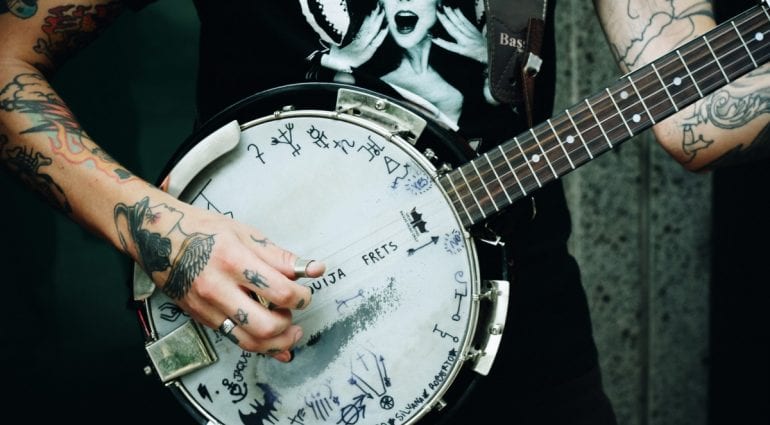
If you have ever had the temptation to delve into the world of the banjo you will first have a few questions: Five-string or four-string? Tenor? 6-string? Or some other model? Relax, we will explain the different types of banjos and their particularities.
A banjo consists of, among other parts, a pot/flange/resonator made of wood and / or metal, covered with a head (traditionally, animal skin was used), like a drum. At one end of this drum we find the heel of the neck, and on the other the tailpiece, which holds the strings. In the centre of the head, closer to the tailpiece, there is a wooden bridge that is held in place by the pressure of the strings and through which the vibration of the strings is transmitted to the head. As a result, a lot of energy is transferred quickly to the head therefore we lose “sustain” but gain a lot of volume.
Warning! Banjos can be very loud
It seems that the instruments they had in the past were too quiet and that is why they invented two components to make it sound louder: the resonator and the tonal ring. The resonator is like a bowl attached to the back of the body (on a banjo that is not “open back”). It reflects the sound it receives from the front and returns it again. The tonal ring is a large metal ring mounted between the wooden structure of the body and the head. Whenever a banjo has these two parts it will sound stronger than an open back banjo. But they can also weigh up to 6 kilos or even more (in fact for that reason there are still banjos without resonators or tonal rings). They do not have to be very expensive, there are some for small budgets like this Harley Benton HBJ-25.
Five-string: The Traditional
Although there are different variants of banjo, this is the model considered by many musicians as unique and genuine. And in fact it is the first modern banjo model. Almost 200 years ago they had no frets and the strings were made of catgut (dried twisted intestines of sheep or horses, not cats). In fact, today there are still experts who play these types of banjos.
The fifth string is the highest in pitch (although it goes right after the lowest), is shorter than the rest and starts at the fifth fret. It is almost always played open, although sometimes the thumb is used to change its pitch.
You will notice that as soon as you step up in level the prices of the banjos rises significantly. But there are also simple and economical models such as the Recording King Dirty 30s Open Back Banjo or the Epiphone MB-100. Also worth checking out is the Deering Goodtime Banjo Starter Package: an ideal option for beginners that includes a Made in USA instrument, a carrying bag, strap, finger picks, tuner and a DVD to learn banjo techniques.
Four-string: Dixie Jazz
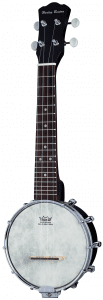 The loud volume of this banjo makes it a perfect survivor in noisy environments. For the same reason, in the past, this type of banjo was used as a rhythm instrument. It has a shorter scale and uses a higher tuning: if it’s a Tenor the strings are tuned to C-G-D-A and if it’s Celtic, G-D-A-E (one octave below the mandolin).
The loud volume of this banjo makes it a perfect survivor in noisy environments. For the same reason, in the past, this type of banjo was used as a rhythm instrument. It has a shorter scale and uses a higher tuning: if it’s a Tenor the strings are tuned to C-G-D-A and if it’s Celtic, G-D-A-E (one octave below the mandolin).
This type of banjo became popular during the 1920’s. At the moment this instrument can especially be seen in bands that play Dixie Jazz or Irish and Celtic music. A great option is this Deering Goodtime 17-Fret Tenor.
A very popular variant of the four-string banjo is the Banjolele (banjo + ukulele), like the Harley Benton BJU-10 Banjo Ukulele.
Six-string: the most underrated
What happens if you mix a guitar and a banjo? Well, we have a six-string banjo, or a banjo guitar. It is tuned like a guitar (E-A-D-G-B-e). This is the perfect banjo for those guitarists who don’t feel like learning a new instrument from scratch and just want that tone and twang of a banjo. A small change can bring great new ideas and the best thing is that it will not cost you much with this Harley Benton HBJ-26 6-String Banjo. Although if you are looking for an even more traditional sound I would recommend this other long-scale Harley Benton BJ-65Pro 6 String Banjo.
So how do I decide?
If you have ever bought an instrument you will already know the key points: first of all, it has to feel good to you, with a neck that is shaped perfectly for the size and shape of your hands, without any uncomfortable edges. It should also be noted that the frets should not protrude from the wood due to shrinking (which is not usually a problem with the wood we choose, in our humidity-controlled environment), but these are things that can be fixed in any workshop.
The instrument must be perfectly set-up: Neck adjustment, the position of the strings, the tension of the head and the position of the bridge. We take particular care that all our banjos come out of the workshop fully set-up and ready to play.
Am I forgetting something?
If you have already decided to buy a banjo, think about accessories. As you know, you’ll have to protect the instrument, so a case or gig bag will come in handy, as well as a tuner. As we mentioned before, sometimes banjos can weigh a lot, that’s why a good strap can save you a lot of physical problems. If your thing is playing clawhammer style you can learn with Mel Bay, but you will need finger picks.
Yee-Haw! ?
2 comments
Leave a Reply
You are currently viewing a placeholder content from Facebook. To access the actual content, click the button below. Please note that doing so will share data with third-party providers.
More InformationYou are currently viewing a placeholder content from Instagram. To access the actual content, click the button below. Please note that doing so will share data with third-party providers.
More InformationYou are currently viewing a placeholder content from X. To access the actual content, click the button below. Please note that doing so will share data with third-party providers.
More Information


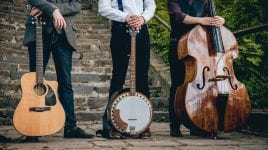
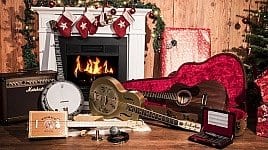
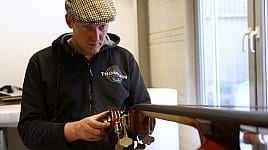


Harry Anderson says:
I would love to -lay a BANJO i bought myself a GUITAR but find my hand is small and cannot reach the chords on the neck plus i have a loose grip on the neck so it sounds bad
Len Eaves retired says:
We all have that problem when we first start to learn any instrument , consentrait on the first 4 strings , Leave the E and A alone for now , By just playing the D.G,B,and E that’s from the thin first string E not so much pressure is needed and you will be able to reach most cords easier , Until you’re hand and fingers become moor suppl and stronger Have Fun learning ,Practice little but often